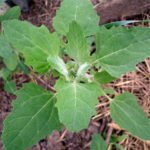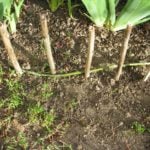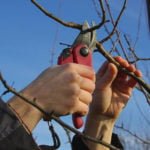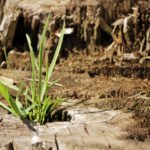“The larvae of the may beetle eat everything in their path!”it’s the groan of a tortured summer resident! How much work is done, how much effort is invested in garden beds and flower beds, and they spoil everything!
Hands actually go down… and there is no way to quickly and simply destroy pests.
With a gun on bee wolf
On terrible beast before with a spear walked, now with wolves Yes, bears only hunters occasionally, and the beast began to count wasps, bees call them wolves. Ways to destroy these insects have invented many.

Bee wolf got the bee. It will feed its larvae, which live in burrows
And for all the horror stories somehow forgot that wasps-the most useful insects.
What is the use of wasp
For a start look at them. Wasps-very beautiful and graceful creatures: they have a thin waist, they are wonderful gymnasts. All parameters Barbie dolls they are given for a reason. For insect control requires speed, strength, stability.
Adult insects feed on nectar, fruits, and larvae are grown on a “meat”, more correctly, protein diet. Wasps destroy a huge number of insects, which gardeners and gardeners consider harmful.

Wasp with prey
Who will help to cope with the larvae of the cartilage and Rhino beetle? Scolia and typhoid wasps will help. They are not the closest relatives, but the nutritional preferences of their children are the same. Lumpy wasps feed their larvae paralyzed leaf beetles, weevils. Wasp spilomena so small that makes their nests in the straw, and the kids feed on thrips.
Wasp of typhoid fever
The female finds a larva in the soil or substrate, where she lives. Finding — stings, the poison paralyzes the larva. And tifia lays an egg on this larva, and that it does not fall off, the female glues it, choosing the right place, special for each species of beetles. That’s the technology of survival. After hatching the wasp larva feeds on the body of larvae of the scarab beetle. That is, those thick white worms that fall into the soil of our beds with humus and manure. So it helps to get rid of the June beetles and rhinoceros beetles.
Wasps of scolia
Scolia — wasps are large, other Scola giant grows up to six inches. A sort of flying helicopter and scares. Could not help thinking that if you decide to dine or to defend themselves, so once the whole arm bitten off. However, this wasp is very peaceful. Sting uses only on natural appointment-for billets cannot digest. The man can take a wasp in your hands — it won’t sting, apparently, such a huge larva. To be cautious is with paper wasps — these stinging, if they do not like.
Scolia Wasp feed their children with larvae of beetles, rhinoceros beetles. They do it very efficiently. On the island of Mauritius imported from Madagascar pickles fought with the Rhino beetle, and pickles from the Philippines fought with the crackle in Hawaii.

Scolia Wasp hairy on the flower
Scolia Wasp -females in white light creep only in order to eat the nectar of lilies and asters, but to meet up with Beau to the kids for light to produce. The rest of the time they spend in the ground, looking for larvae there. Finding, making an underground passage under the larva, paralyzes it, and lays an egg.

Scolia Wasp
Paper wasps
They fly into the kitchen and climb into the jam. Paper wasps live families, building houses of chewed rotting wood. For the larvae to catch any insects flying or crawling. The main criterion of choice-the wasp should have enough strength to overcome the future feed in the fight.
Wasps in the wall
Wall wasp – cousin of the paper, they feed their children paralyzed larvae of beetles of elephants, beetles and borers, caterpillars of the moth. Spiked wall wasp
specializes on the larvae of the weevils of the genus Phytonomus.
Sawn wasps
Wasp sawn wasps people call Potter.

Pupae of wasps-a Potter
It brings their kids caterpillars of moths, tortrix moths, moth.
Wasps German
The German wasp is preparing the meat for their larvae caterpillars of butterflies, the larvae of sawflies and flies.
Wasps digging
Who is able to deal with a mole cricket? She finds a bear in the ground, drives it to the surface, stings in three thoracic segments and, while the bear is in a state of stupor, lays an egg under the base of the anterior leg (it somehow sounds too scientific, to put it simply, the armpit). Then the cricket comes back to life and once again crawls under the ground, carrying the egg in a secluded place. The wasp larva will feed on the bear.
Sand wasps
If caterpillars winter Cutworm tired, you get pescarola sand. This wasp in the ground digs a hole and drags it caught and paralyzed a caterpillar shovels, which is heavier than most hunters every ten, and even fifteen.

Sandstone sand with prey
Biting into a burrow, lays on a “canned” egg. Sometimes and two caterpillars will bring.
Bembix nosed
Bembix nosed catches flies and flies, when they sit on flowers, and on the fly also catches. Flies deftly takes on the skin of cattle.

Bembix nosed when building nests of pebbles removes jaws
Bembix is a very caring parent, he brings food to his offspring every day. For the growth of each larva required approximately 60 flies, horse flies are larger — they have 24 pieces.
Wasp ammophila
Ammophila feed their larvae with caterpillars scoop. They can smell the caterpillars in the ground after all those during the growth of deep hiding. Sandy ammophila dig caterpillars and stinging. Fluffy ammophila bring each kid a dozen caterpillars of moths.
Wasp need to secure
Well, a wasp flew in the room… Cover it with the glass jar, close the neck with a sheet of paper, take outside, release the wasp into the wild. See the mink? Insulate the place with pots of petunias-let the wasps work: they arrive to live where there is food for larvae, where you can raise offspring. Let them live in the areas. Then worm apples and plums will be less, and without any processing. And the raspberries to macerate in salted water do not have — there will be little worms. Summer resident will help wasps — wasps will help cottagers.

















